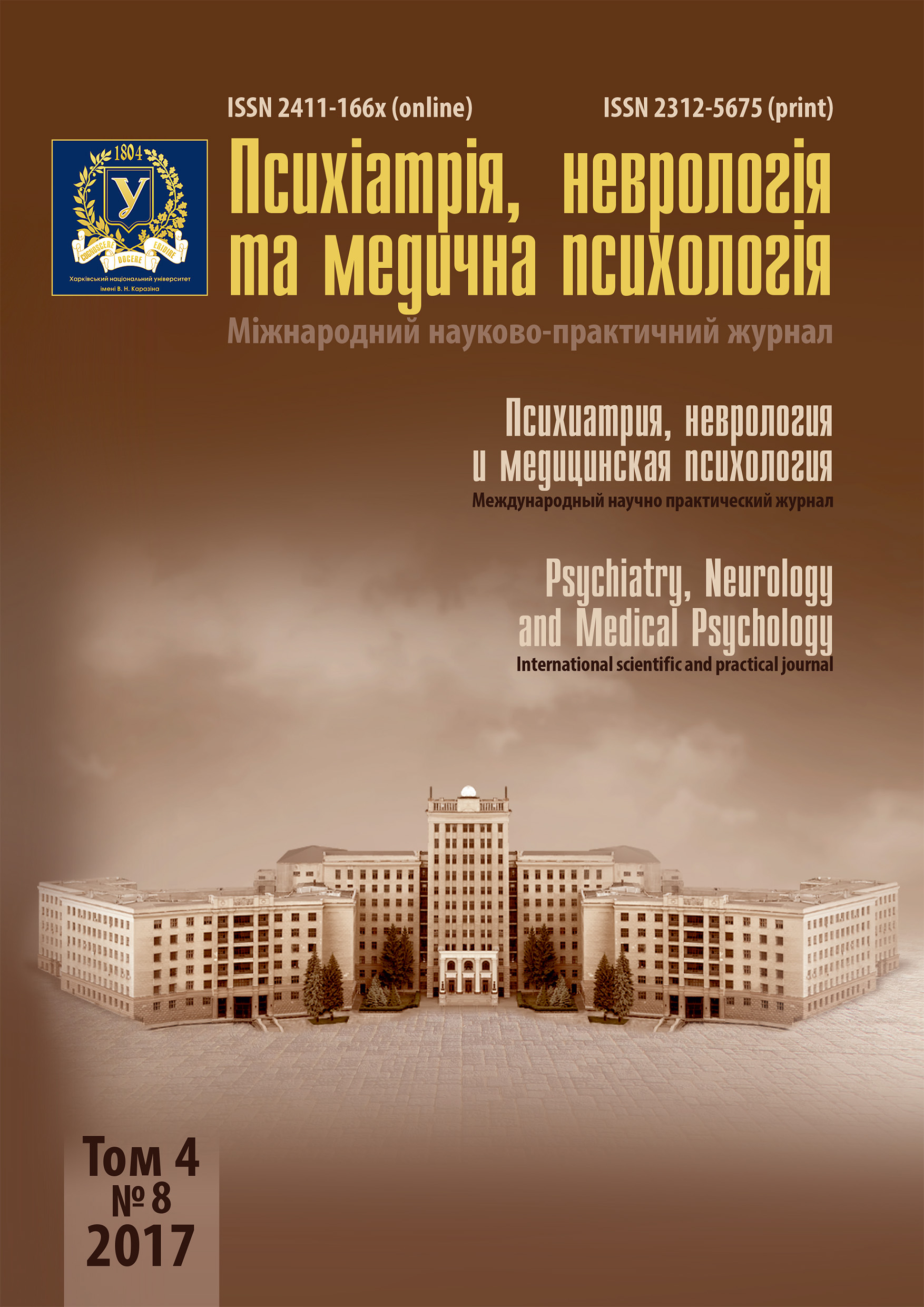Psychological diagnostics of risky behavior of adolescents
Abstract
The article reflects practical results of the research on adolescent risky behavior and specifically – the psychodiagnostics stage. Traditionally therapeutic impact on risky adolescents is not quite effective. We assume that the main reason of poor efficiency of the psychological correction of risky behavior lies in the inability to address precise factors that stand out for particular adolescent since these factors may vary substantially. In our research we were able to distinguish three factors and their wide array of components that affect adolescent’s engagement into such types of behavior. Grounding on those we elaborated a detailed procedure for running psychological diagnostics that enables to identify and to further impact actual psychological targets during further coming psychological correction classes. The psychodiagnostics procedure aims at analyzing the following phenomena: adolescent’s predisposition to self-harming and suicidal behavior; current pshyco-emotional state; attitude to self and its components; stress-resilience; typical coping strategies and psychological adaptation. The proposed system of methods also enables to identify every adolescent’s strengths that a psychotherapist can employ as the basis for new skills’ development.Downloads
References
Березин С. В. Технология формирования социальных
навыков : методическое пособие для психологов и социальных педагогов ИТУ / С. В. Березин, К. С. Лисецкий. – Самара, 1999. – 198 с.
Рахимкулова А. С. Рисковое поведение подростков и психическое здоровье / А. С. Рахимкулова // Fundamental and applied researches in practice of leading scientific schools. – 2016. – Vol. 5(17). – P. 99–113.
Рахимкулова А. С. Трехфакторная модель рискового поведения у подростков с суицидальными мыслями и намерениями / А. С. Рахимкулова // Медицинская психология. – 2017. – Т. 12 (2). – С. 51–56.
Столяренко Л. Д. Основы психологии : практикум /Л. Д. Столяренко. – Ростов н/Д. : Феникс, 2006. – 279 с.
Пашукова Т. И., Допира А. И., Дьяконов Г. В. Психологические
исследования. Практикум по общей психологии для студентов педагогических вузов / Т. И. Пашукова, А. И. Допира, Г. В. Дьяконов. – М. : ИПП, 1996. – 326 с.
Прихожан А. М. Диагностика личностного развития детей подросткового возраста /А. М. Прихожан. – М. : АНО «ПЭБ», 2007. – 56 с.
Рахімкулова А. С. Взаємозв’язок ризикової та суїцидальної поведінки у підлітків в Україні / А. С. Рахімкулова // Проблеми сучасної психології : зб. наук. пр. / ред. С. Д. Максименко, Л. А. Онуфрієва ; Кам’янець- Поділ. нац. ун-т ім. І. Огієнка, Ін-т психології ім. Г. С. Костюка АПН України. – Кам’янець- Подільський : Аксіома, 2016. – Вип. 34. – № 34. – C. 446–470.
Психологическая диагностика : учебное пособие / под ред. К. М. Гуревича, Е. М. Борисовой. – М. : УРАО, 1997. – 281 с.
Павлова Т. С. Диагностика риска суицидального поведения детей и подростков в образовательных учреждениях / Т. С. Павлова
Современная зарубежная психология. – 2013. – № 4. – С. 79–91.
Сборник психологических тестов. Часть III: Пособие / сост. Е. Е. Миронова. – Минск : Женский институт ЭНВИЛА, 2006. – 120 с.
Большая энциклопедия психологических тестов / сост. А. А. Карелин. – М. : ЭКСМО, 2006. – 416 с.
Бурлачук Л. Ф. Психодиагностика : учебник для вузов / Л. Ф. Бурлачук. – СПб. : Питер, 2003. – 351 с. : илл. – (Серия «Учебник нового века»).
Подольский А. И. Психоэмоциональное состояние подростков: актуальное состояние и пути улучшения / А. И. Подольски // Материалы Всероссийской научно-практической конференции Личностно- ориентированный подход в воспитании и дополнительном
образовании школьников. – 2005. – С. 18–39.
Барлас Т. В. Психодиагностика в психологическом консультировании: задачи и подходы / Т. В. Барлас // Журнал практической психологии и психоанализа – 2003. – Т. 1(1). – С. 28–41.
Леонгард К. Акцентуированные личности / К. Леонгард ; под ред. В. М. Блейхера. – К. : Выща школа, 1989. – 289 с.
Щекин Г. В. Визуальная психодиагностика / Г. В. Щекин. – М. : МАУП, 2001. – 616 с.
Сборник психологических тестов : пособие. Ч. II / сост. Е. Е. Миронова. – Минск : Женский институт ЭНВИЛА, 2006. – 146 с.
Романова Е. С. Психодиагностика : учебное пособие / Е. С. Романова. – 3-е изд., доп. – М. : КНОРУС, 2011. – 336 с.
Карманов А. А. Методика диагностики основных параметров психического состояния тестом Люшера / А. А. Карманов. – СПб. : Питер, 2000. – 189 с.
Двинин А. П. Современная психодиагностика : учебно-практическое руководство /А. П. Двинин, И. А. Романченко. – СПб. : Речь, 2012. – 283 с.
Немов Р. С. Психология : учебник для студентов высших педагогических учебных заведений : в 3 кн. / Р. С. Немов. – 4 изд.– М. : Гуманитарный издательский центр “Владос”, 2001. – Кн. 3: Психодиагностика. Введение в научное психологическое исследование с элементами математической статистики. – 640 с.
Психодиагностика и психокоррекция / под ред. А. А. Александрова. – СПб. : Питер, 2008. – 384 с. : илл. (Серия «Мастера Психологии»).
Панцырь С. Н. Самоотношение подростков с девиантным поведением / С. Н. Панцырь // Психологическая наука и образование. – 2012. – № 1. – С. 24–29.
Демина Л. Д. Психическое здоровье и защитные механизмы личности / Л. Д. Демина, И. А. Ральникова. – Барнаул : Изд-во Алтайского государственного университета, 2000. – 123 с.
Набиуллина Р. Р. Механизмы психологической защиты и совладания со стрессом (определение, структура, функции, виды, психотерапевтическая коррекция) : учебное пособие / Р. Р. Набиуллина, И. В. Тухтарова. – Казань, 2003. – С. 23–29.
Шевандрин Н. И. Психодиагностика, коррекция и развитие личности : учебник для студентов высших учебных заведений / Н. И. Шевандрин. – 2-е изд. – М. : Владос, 2001. – 512 с.
Диагностика социально-психологической адаптации (К. Роджерс, Р. Даймонд) / Н. П. Фетискин , В. В. Козлов, Г. М. Мануйлов // Социально-психологическая диагностика развития личности и малых групп. – М. : Изд-во Института Психотерапии. – 2002. – C. 193–197.
Copyright (c) 2018 Анастасия Станиславовна Рахимкулова

This work is licensed under a Creative Commons Attribution 4.0 International License.

